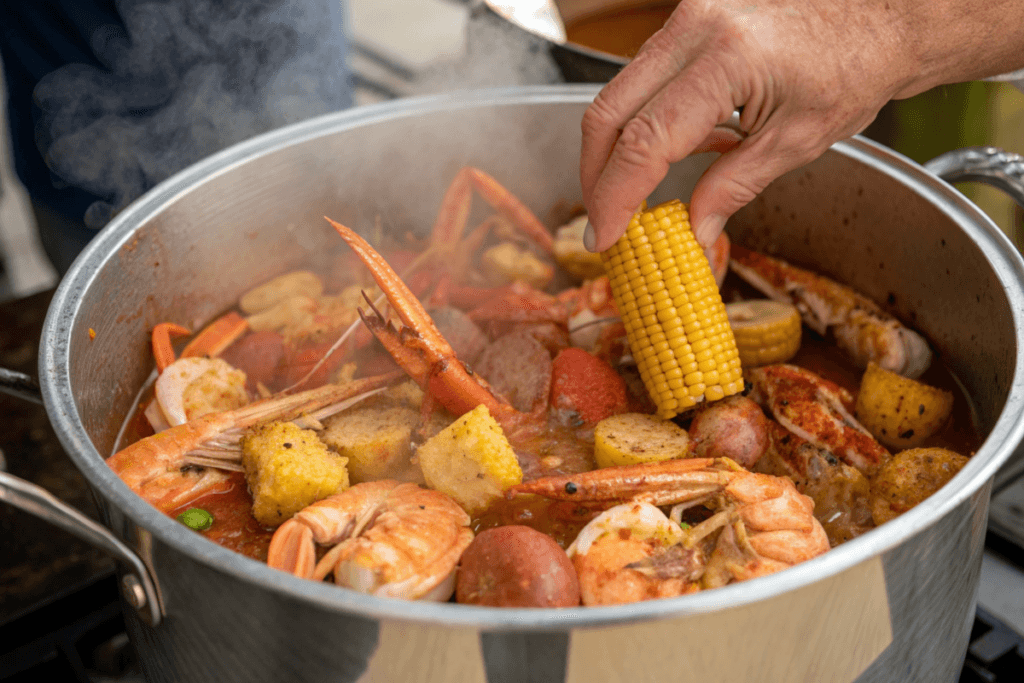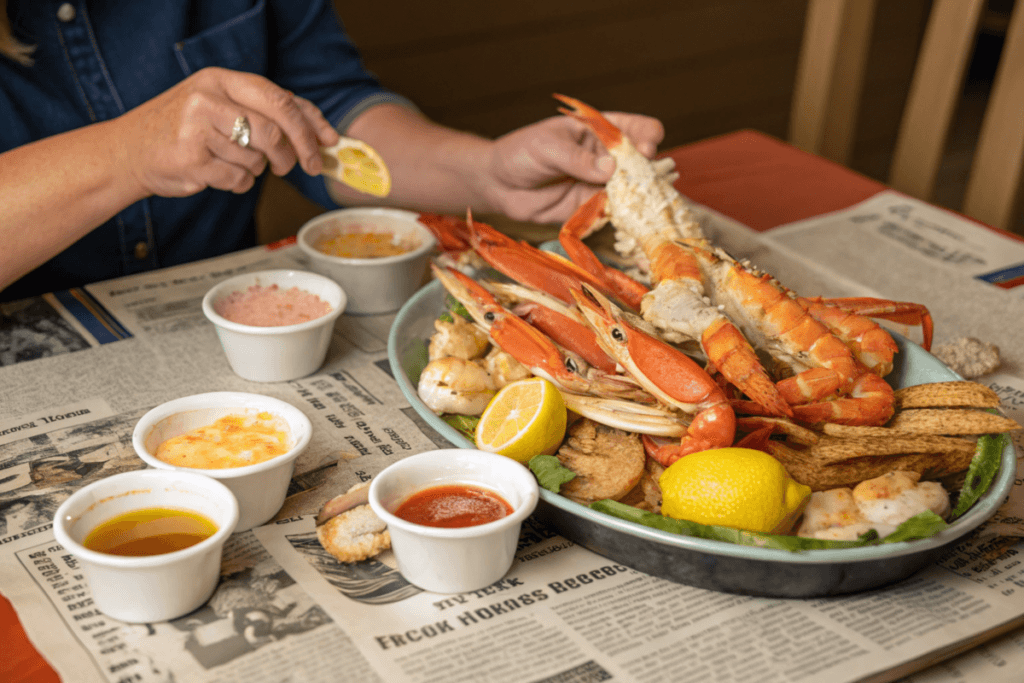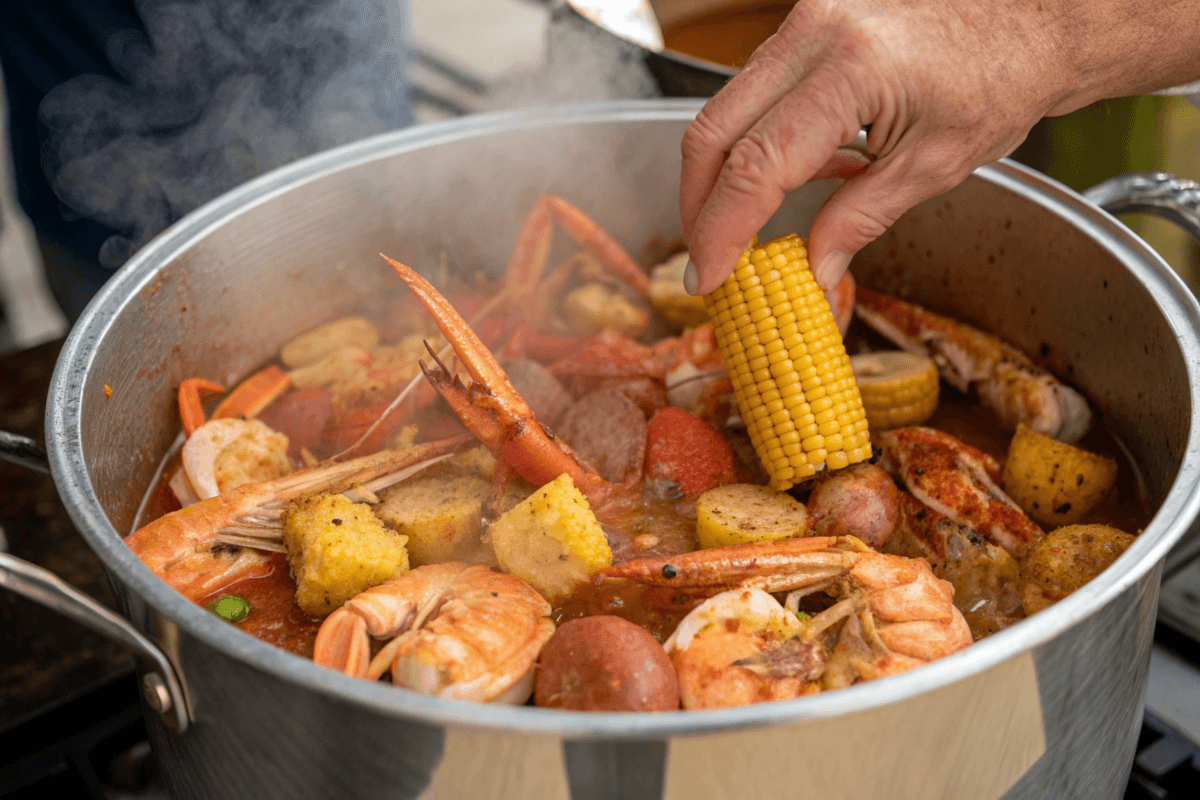The seafood broil is an unbeatable way to bring people together over a hearty, flavorful meal. This cherished culinary tradition combines fresh seafood, hearty sides, and a medley of spices to create a dish that’s as much about the experience as it is about the taste. Whether you’re planning a backyard gathering or craving a comforting feast, a seafood broil is a perfect choice.
In this guide, we’ll dive into everything you need to know about making an unforgettable seafood broil. From selecting the freshest ingredients to crafting a perfectly seasoned broth and serving it with flair, we’ve got you covered. You’ll also discover regional twists, insider tips, and answers to commonly asked questions.
What is a Seafood Broil?
Origins and Cultural Significance
The seafood broil has its roots in coastal traditions where communities celebrated the bounties of the sea. Born in regions like the Southern United States and New England, this dish quickly became synonymous with festive gatherings. Each area puts its own spin on the recipe, making it a versatile and culturally rich meal.
Whether it’s a Cajun-inspired broil in Louisiana or a clam boil in New England, the essence remains the same: fresh seafood cooked in a spiced broth and served family-style. Over time, this hearty dish has gained popularity beyond coastal regions, becoming a staple at parties and summer get-togethers.
Key Ingredients in a Seafood Broil
At its core, a seafood broil features a mix of shrimp, crab, clams, or lobster. Supporting ingredients like corn on the cob, baby potatoes, and sausages round out the meal, adding a balance of textures and flavors. The secret lies in the seasoning—Old Bay, garlic, lemon, and bay leaves are popular choices that create a fragrant and spicy base.
Why It’s a Popular Choice for Gatherings
There’s something inherently communal about a seafood broil. The act of gathering around a table, cracking shells, and dipping morsels into butter fosters connection. Plus, it’s customizable—guests can enjoy a little of everything or focus on their favorites. Easy to prepare in large quantities, it’s a crowd-pleaser that leaves bellies full and spirits high.
Choosing the Right Ingredients for Your Seafood Broil
Fresh Seafood Selection
When it comes to a seafood broil, the star ingredients are undoubtedly the seafood. Opt for fresh, high-quality shrimp, crab, lobster, and clams to ensure maximum flavor and freshness. Look for seafood with clear eyes, firm texture, and a pleasant ocean smell—these are signs of freshness. For those living inland, frozen seafood can be a great alternative, as it’s often flash-frozen to preserve its quality.
When buying clams, ensure they’re tightly closed, as open clams might indicate they’re no longer alive. Shrimp should have a translucent, slightly glossy shell. Don’t forget to ask your fishmonger for advice on what’s in season for the best quality and price.
Supporting Ingredients: Potatoes, Corn, and Sausages
No seafood broil is complete without hearty accompaniments like potatoes, corn on the cob, and smoked sausages. Baby potatoes are ideal since they cook quickly and absorb the seasoned broth beautifully. Sweet corn adds a touch of natural sweetness that balances the dish, while sausages bring a savory depth. Slice your sausages for faster cooking and easier serving.
Seasonings and Spices for the Perfect Flavor
The magic of a seafood broil lies in its seasoning. Classic options include Old Bay, Cajun seasoning, paprika, garlic powder, and thyme. Lemon wedges and fresh parsley add a refreshing zest to the final dish. Combine these spices with bay leaves and a generous pinch of salt to create a rich, aromatic broth.
If you’re looking to explore more recipes, consider checking out this seafood boil bag guide on GiddyRecipes.
Preparing for the Perfect Seafood Broil
Tools and Equipment You’ll Need
To execute a seafood broil like a pro, you’ll need a large stockpot or a turkey fryer with a basket insert. These ensure even cooking and make draining easy. A propane burner is ideal for outdoor boils, but stovetop setups work well for smaller gatherings. Don’t forget a slotted spoon for stirring and serving, and have newspapers or serving trays ready for the classic family-style presentation.
Prepping Ingredients: Washing, Chopping, and Sorting
Preparation is key. Rinse all your seafood thoroughly under cold water to remove sand and debris. Scrub clams and mussels, discarding any with cracked shells. Wash your potatoes and corn, and chop your sausages into bite-sized pieces. Sorting your ingredients into cooking-order piles will streamline the process.
Setting Up Your Cooking Space
Set up a clean and spacious cooking area, whether outdoors or indoors. Have your seasonings, ingredients, and tools within easy reach. If cooking outdoors, ensure your burner is stable and away from windy areas for safety.
Step-by-Step Guide to Cooking a Seafood Broil
Creating the Perfect Broth Base
The secret to a delicious seafood broil lies in its aromatic broth. Start by filling your pot halfway with water and adding a blend of spices like Old Bay, garlic, thyme, and bay leaves. Squeeze in the juice of a few lemons, then toss in the rinds for extra zest. Bring this mix to a rolling boil and let it simmer for 10-15 minutes to develop its full flavor.
For an extra kick, consider adding a splash of beer or white wine. This not only enhances the broth but also imparts a subtle depth to the seafood.
Layering Ingredients for Optimal Flavor
Timing is everything when cooking a seafood broil. Begin with the ingredients that take the longest to cook, like potatoes and corn. Let them boil for 10-12 minutes before adding the sausages. The flavors from the sausages will infuse into the broth, creating a savory base.
Once these are nearly tender, it’s time for the seafood. Add your clams and mussels first, as they take a few minutes to open. Follow up with shrimp, crab legs, and lobster tails. The seafood should be immersed in the boiling liquid but cooked just until tender to avoid overcooking.

Final Touches and Tips for Perfection
After everything is cooked, remove the pot from heat and let the ingredients steep for a few minutes to absorb the flavors fully. Drain the mixture and spread the seafood, sausages, and vegetables on a newspaper-covered table or serving tray. Sprinkle everything with additional Old Bay or parsley for presentation.
If you love discovering new cooking ideas, check out this guide to delicious seafood platters.
Serving and Enjoying Your Seafood Broil
Presentation Ideas: Newspaper Style vs. Serving Trays

One of the joys of a seafood broil is its casual, communal style. The classic presentation involves spreading the cooked feast across a newspaper-covered table. This rustic approach makes cleanup a breeze and fosters a relaxed dining experience. Alternatively, arrange the food on large serving trays for a more polished look, perfect for indoor settings or formal gatherings.
Condiments and Sides to Pair with Your Broil
Enhance your seafood broil with complementary condiments and sides. Melted butter with garlic is a must-have for dipping, while cocktail sauce and lemon wedges add brightness. For sides, consider serving crusty bread to soak up the broth, a fresh green salad, or coleslaw for a refreshing crunch.
Tips for Eating Like a Pro
Eating a seafood broil can be a hands-on, messy affair, but that’s part of the fun! Provide plenty of napkins, seafood crackers for cracking shells, and small bowls for discarded shells. Encourage guests to dig in, savoring the flavors and textures of the seafood and accompaniments.
For more ways to elevate your meal, explore this ultimate seafood seasoning guide to perfect your broil.
Variations and Regional Twists on Seafood Broi
Cajun-Style Broil
The Cajun-style seafood broil is a fiery favorite, bursting with bold flavors. Originating in Louisiana, this variation incorporates generous amounts of Cajun seasoning, cayenne pepper, and smoked paprika. Andouille sausage is a must, adding a smoky, spicy kick. Corn and red potatoes are staples, soaking up the richly seasoned broth. A touch of butter, infused with garlic and spices, is often poured over the finished dish for a decadent finish.
Cajun seafood broil is perfect for those who love their meals with a spicy flair. Pair it with a cold beer to balance the heat.
New England Seafood Boil
New England puts a milder, more traditional twist on the seafood broil. Clams, mussels, and lobster take center stage, often paired with sweet corn and baby potatoes. The broth is typically lighter, seasoned with salt, pepper, bay leaves, and a touch of white wine or beer. Instead of sausage, this version sometimes includes fresh fish for added variety.
Serve the New England seafood broil with melted butter and lemon wedges to highlight the seafood’s natural flavors.
Adding Exotic Flavors: Asian and Mediterranean Twists
For a global take, try incorporating Asian or Mediterranean flavors. In the Asian version, ginger, soy sauce, and sesame oil create a savory, umami-packed broth. Mediterranean influences include olive oil, garlic, oregano, and lemon, offering a refreshing, herbaceous profile. Both variations bring a unique flair to the classic seafood broil.
FAQs About Seafood Broil
What Are the Best Substitutes for Seafood in a Broil?
If you have guests with seafood allergies, try substituting chicken drumsticks, sausages, or hearty vegetables like zucchini and mushrooms. The seasoned broth works beautifully with these alternatives, ensuring everyone can enjoy the experience.
How Do I Store Leftovers from a Seafood Broil?
Leftovers should be refrigerated within two hours to maintain freshness. Store the seafood, vegetables, and sausages separately from the broth in airtight containers. To reheat, gently warm the items in a pan with a splash of broth or butter to retain their moisture.
Can I Cook a Seafood Broil Indoors Without a Large Pot?
Yes! For smaller gatherings, you can prepare a seafood broil on the stovetop using a large stockpot or Dutch oven. Alternatively, use a slow cooker for a hands-off approach. Just layer the ingredients and let them simmer slowly until cooked through.
What Drinks Pair Well with a Seafood Broil?
A seafood broil pairs wonderfully with crisp white wines like Sauvignon Blanc or a light beer. For non-alcoholic options, consider lemonade, iced tea, or sparkling water infused with citrus for a refreshing complement.
FAQs About Seafood Broil
How Long Should I Cook Each Ingredient?
Timing is everything when preparing a seafood feast. Start with potatoes and corn, as they take the longest—about 10–15 minutes of boiling. Next, add sausages, which need about 5–7 minutes to release their flavor into the broth. Finally, seafood like shrimp, clams, and crab cooks quickly, usually within 5–7 minutes. Keep an eye on clams and mussels—remove them as soon as they open to avoid overcooking.
Can I Customize the Spices?
Absolutely! The seasoning is one of the most flexible parts of the dish. While Old Bay and Cajun spice blends are staples, don’t be afraid to get creative. Chili powder adds heat, smoked paprika gives a rich depth, and Mediterranean flavors like oregano and garlic offer a fresh twist. For an Asian-inspired variation, consider ginger, soy sauce, and sesame oil to complement the seafood.
Is It Healthy?
This dish can be a nutritious option, especially with lean proteins like shrimp, clams, and lobster. These seafood choices are loaded with omega-3 fatty acids, zinc, and vitamin B12. To keep it lighter, limit the butter and opt for low-sodium seasonings. The addition of vegetables like corn and potatoes adds fiber and essential nutrients, making it a balanced meal.
How Should I Serve It for a Party?
Serving this dish family-style is both practical and fun. Spread the cooked ingredients across a newspaper-covered table for a rustic presentation that encourages interaction. Include melted butter, lemon wedges, and a variety of dipping sauces so everyone can customize their bites. This casual setup makes the meal memorable and easy to clean up.
Conclusion
A seafood broil is more than just a meal—it’s an experience that brings people together. Whether you prefer a traditional New England version or a bold Cajun twist, the versatility of this dish makes it perfect for any occasion. By carefully selecting fresh ingredients, layering flavors in the broth, and timing each step, you can create a feast that delights your guests.
Don’t forget to customize the seasonings and accompaniments to suit your preferences. From melted butter and lemon wedges to creative side dishes, there are countless ways to elevate your seafood broil. It’s a celebration of the sea’s bounty, paired with hearty vegetables and savory sausages, making it a well-rounded and satisfying meal.
In the end, a seafood broil is all about enjoying good food, great company, and the simple pleasure of a shared meal. Whether you’re hosting a summer bash or craving comfort on a cool evening, this dish is sure to impress. So grab a pot, gather your ingredients, and get ready to make your own unforgettable seafood broil!

